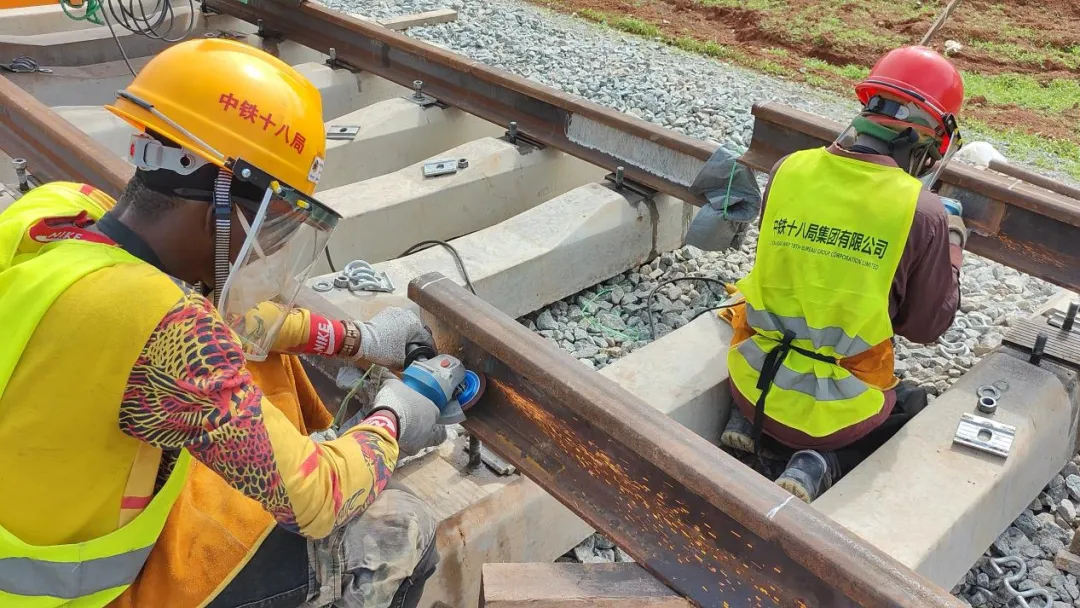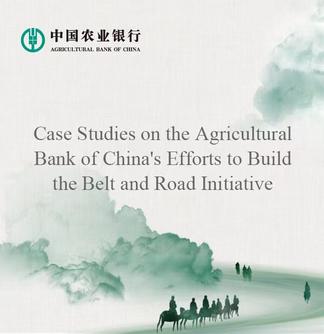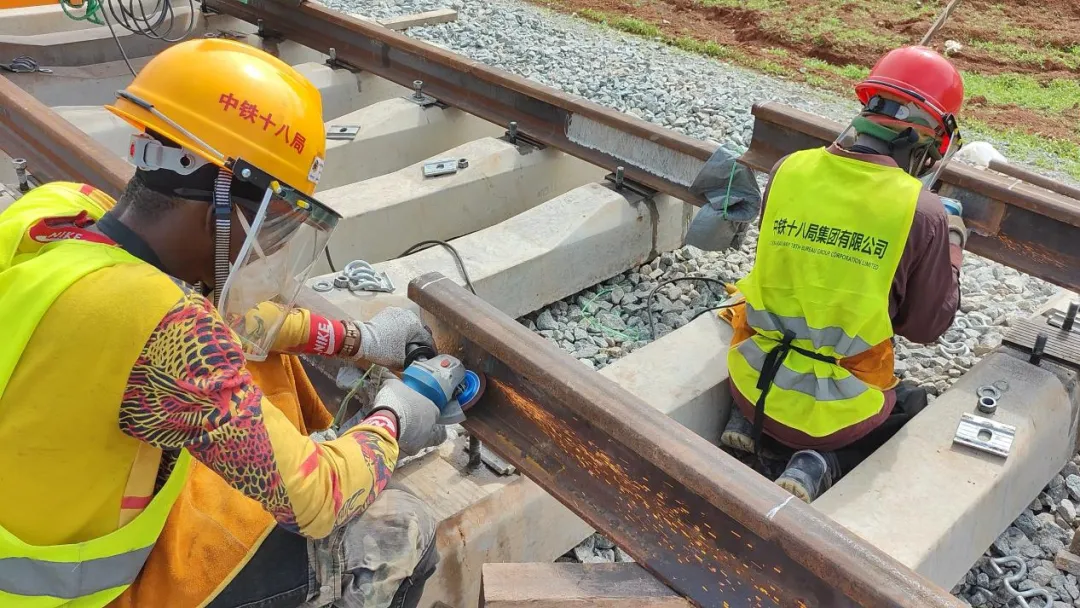
The picture shows workers grinding the rails before welding. (Photo provided by China Railway 8th Bureau Group)
In Guinea, on the west coast of Africa, the Simandou iron ore mine, nestled between mountains and dense forests, is witnessing an unprecedented "awakening" of resources. This long-dormant deposit, one of the world's largest and highest-grade untapped hematite mines, is set to reshape the global iron ore landscape. And now, it is being awakened. In this process, the financial support provided by the Agricultural Bank of China (ABC) has become a lifeline from China.
In 2023, ABC participated as a syndicate loan co-lender in the Simandou South Block Iron Ore Project (hereinafter referred to as the "Simandou Project") of Aluminum Corporation of China (Chinalco). This is not only a financial cooperation but also a financial practice that bridges geographical and institutional divides and promotes a win-win situation for resource development and growth.
"Win-Win Development Model" Helps Address Core Challenges in Guinea
The Simandou iron ore mine has been a "strategic treasure" coveted by international mining giants since the late 20th century. However, the complex and volatile political situation in Guinea, as well as the huge infrastructure investment requirements, have made the development process extremely challenging. The project once got stuck in disputes over mining rights and bottlenecks in infrastructure construction, and the intervention of international mining giants failed to break the deadlock.
What truly changed the situation was the "win-win development model" brought by Chinese power: Chinese enterprises not only led the construction of a railway artery connecting the mining area and the port, but also addressed the core challenges of Guinea's development with three large hydropower stations and the commitment to build two new towns. Eventually, this led to an equity cooperation among Chinese enterprises, Rio Tinto, and the Guinean government, making this "sleeping treasure" truly have the potential to realize its value.
In 2022, Chinalco, Rio Tinto and other stakeholders jointly initiated the development of the third and fourth blocks of the Simandou iron ore project, along with the construction of a port, power plant and railway. This truly sounded the clarion call for large-scale construction. The project is not merely about "iron ore mining", but a comprehensive large-scale project involving "iron ore + railway + port + power + industrial chain", which has provided greater economic assistance to Guinea than any previous international resource development projects. It has set a new benchmark for the joint construction of the Belt and Road cooperation.
Guinea's President Mamadi Doumbouya stated outright that the Simandou project is the largest and historically significant mining project in Africa. The Minister of Environment and Sustainable Development of Guinea, Djami Diallo, also said that this is an extraordinary project consisting of mining and infrastructure.
In October 2025, the first batch of high-grade iron ore from the Simandou iron mine was shipped out. This not only marked the end of the "duopoly" era in international iron ore supply, but also became a key pivot for China to achieve strategic breakthroughs in global resource competition, with far-reaching implications. According to the plan, after the full production of both the northern and southern mining areas, they will have the capacity to produce 120 million tons of high-quality iron ore annually.
Without Strongholds: Guinea Venture Tests Chinese Banks' New Pattern to "Go Global"
The Simandou project is not only a major undertaking for Guinea but also a profound test for China's cross-border financial system. China's infrastructure advantages, resource integration capabilities, and the coordinated operation of its financial system have been prominently demonstrated in this project.
Chinalco, through its subsidiary Chinalco Overseas, organized a syndicated loan for the project, which included the development of the Simandou 3 and 4 mining blocks and the construction of railways and ports. The project's financing requirement has amounted to 3.266 billion U.S. dollars. The syndicated loan is led by the Export-Import Bank of China and the China Development Bank, with the participation of the Bank of China, Industrial and Commercial Bank of China, China Construction Bank, and ABC. The loan term is 15 years, and Chinalco provides full and continuous joint liability guarantee. Among them, ABC's participation amount is 500 million U.S. dollars.
In February 2025, ABC Macao Branch received the approval from the head office for the syndicated loan of this project. After the lead banks complete the allocation of the loan amount and sign the loan agreement, ABC Macao Branch will disburse the funds according to the project progress, providing financial support for the project to be implemented as planned.

The picture shows the ongoing construction of the Simandou Railway. (Photo provided by China Railway 18th Bureau Group)
Large investment scale, long project cycle, multiple risk points... ABC needs to solve not only the matching of funds but also the full-process control of complex cross-border projects. As a member of the syndicate, the bank has no branches in Guinea but still successfully participated in the financing of this large-scale overseas project, marking a leap in China's cross-border financial service capabilities. It is a beneficial attempt for Chinese financial services to "going global" and a full-chain practice of "resource projects + infrastructure projects + local development + cross-border finance".
Simandou Forges Multi-Win Template for Belt & Road Financial Cooperation
On November 11, 2025, the Simandou project officially entered the production phase, not only providing strategic security for China's steel industry, but also ushering Guinea into a new stage of national income and industrialization.
After the project goes into operation, iron ore exports will bring considerable foreign exchange earnings to Guinea, effectively promoting local economic growth. The construction and subsequent operation of the project will drive the coordinated development of a series of upstream and downstream industries in the country, such as construction, transportation, equipment manufacturing and maintenance, creating numerous business and employment opportunities and further promoting the diversification of the local economy and improving its economic level.
The Koundiayadou Tunnel of the Massi Railway and the track renovation project of the Conakry-Boké Railway (CFB), both undertaken by China Railway 18th Bureau Group, as key supporting projects of the Simandou mining area railway project in Guinea, are reshaping the infrastructure landscape of Africa with Chinese standards. The Simandou mining area railway is hailed as a "major artery" of transportation in Africa, achieving a deep integration of Chinese railway technology standards with African mineral resources. The 98-million-U.S.-dollar international guarantee letter issued by ABC has injected financial credit support into this steel bond.
The 679-kilometer Massi Railway is one of the most strategically significant transportation arteries in West Africa. It not only undertakes the main function of transporting iron ore but is also open to third-party users. The railway connects the remote mining areas in southeastern Guinea with coastal ports, significantly reducing logistics costs and promoting regional trade integration. The planned deep-water port, power facilities and road network will directly enhance the convenience of local residents' lives.
Simandou is not only a mine but also a road; it is not only a financial cooperation but also a win-win move that transcends geography, systems, and cultures. These multi-dimensional changes derived from "iron ore" are making Simandou an important springboard for Guinea's modernization. By participating in the syndicated loan, ABC not only injected crucial financial vitality into the project but also demonstrated the professional capabilities and responsibility of Chinese financial institutions in serving national initiatives and supporting enterprises in going global. It strengthened the Belt and Road cooperation model that links resource development with infrastructure, providing a replicable financial template for deepening China-Africa cooperation and ensuring the stability of industrial and supply chains. (By Xu Yuan)




 A single purchase
A single purchase









